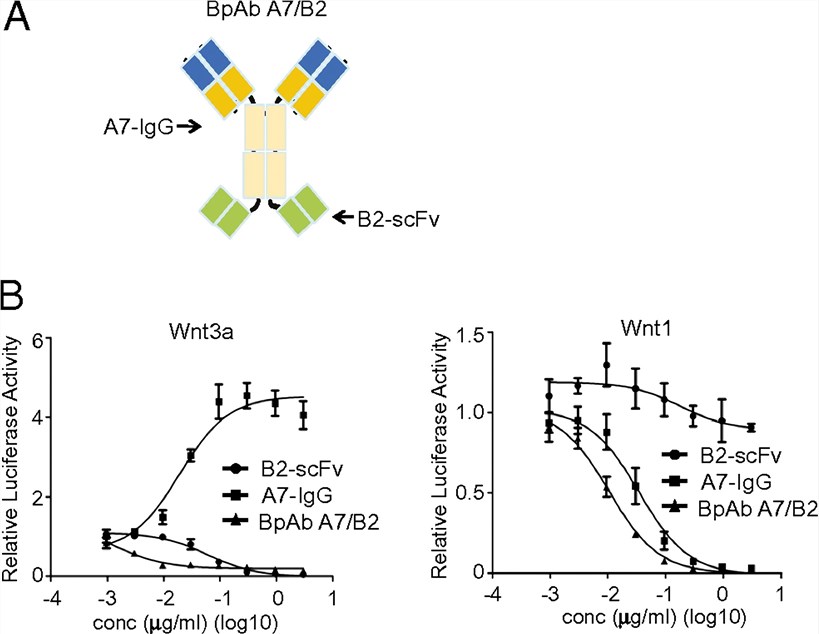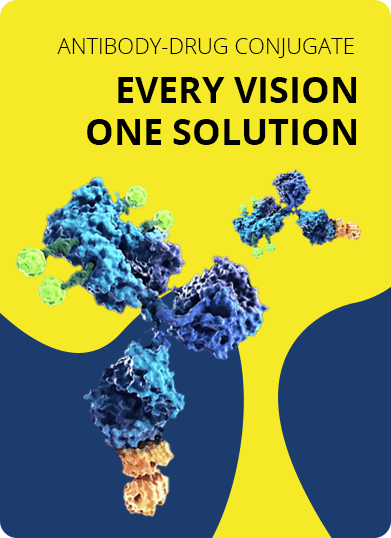- Home
- UTC Development
- Bispecific ADC Development
- Biparatopic Receptor based Bispecific ADC Development
- Biparatopic LRP6-targeted Bispecific ADC Development
Biparatopic LRP6-targeted Bispecific ADC Development Service
The low-density lipoprotein receptor-related protein 6 (LRP6) is a key player in the activation of the WNT/β-catenin signaling pathway and is widely expressed in various cancers. Since antibody-drug conjugates (ADCs) presents the ability to deliver cytotoxic drugs specifically into targeted cells through internalization and lysosomal trafficking, Creative Biolabs hereby provides a generally applicable approach to achieve selective signaling pathway modulation by biparatopic LRP6-targeted bispecific ADCs. We are dedicated to help our clients design and prepare highly customized LRP6-targeted biparatopic bispecific ADCs to boost their project.
Introduction of LRP6
LRP6, a member of the low-density lipoprotein receptor family, has a unique structure, which facilitates its multiple functions as a co-receptor for Wnt/β-catenin signaling and as a ligand receptor for endocytosis. As Figure 1 shown, LRP6 consists of an extracellular domain with four YWTD (Tyr-Trp-Thr-Asp)-type β-propeller motifs (P1-P4), four EGF-like domains (E1-E4), and three LDLR type A domains (L1-L3) close to the transmembrane. Endocytosis of the LRP6-Frizzled receptor complex occurs quickly after WNT binding and single amino acid substitutions of LDLR repeat residues inhibit LRP6 internalization. LRP6 is frequently overexpressed in colorectal, liver, breast, and pancreatic adenocarcinomas in association with increased WNT/β -catenin signaling. Reducing LRP6 expression and/or activity inhibits cancer cell proliferation and delays tumor growth in vivo.
 Fig.1 The structure of LRP6. (Raisch, 2019)
Fig.1 The structure of LRP6. (Raisch, 2019)
LRP6-targeted Therapeutics
Different peptides, small molecules, and antibodies have been shown to exert anticancer properties by directly or indirectly inhibiting LRP6 function. For instance, LRP6 monoclonal antibodies (mAbs) targeting the WNT3 binding site (P3E3P4E4 region) significantly reduce the proliferation and growth of tumorigenic ApcMin/+ organoids. Besides, a bispecific antibody (GSK3178022) targeting LRP6 is capable of blocking stimulation by a range of WNT and R-spondin (RSPO) ligands in vitro. Studies revealed that GSK3178022 potently delayed tumor growth in a patient-derived RSPO fusion model of colorectal cancer (CRC). Furthermore, single-domain antibody fragments (VHH) against the WNT3-binding site have been shown to block Rnf43 mutant intestinal organoid growth and survival, by depleting stem-like tumor cells. In a word, these studies indicate that LRP6 may represent a promising therapeutic target for CRC, in particular for WNT-hypersensitive tumors.
 Fig.2 Biparatopic anti-LRP6 antibody BpAb A7/B2 blocks both Wnt1- and Wnt3a-mediated β-catenin signaling. (Ettenberg, 2010)
Fig.2 Biparatopic anti-LRP6 antibody BpAb A7/B2 blocks both Wnt1- and Wnt3a-mediated β-catenin signaling. (Ettenberg, 2010)
What Can We Do for You?
Since upregulated LRP6 function in tumors is frequently associated with cell malignancy, poor prognosis, and chemo-resistance, LRP6 protein represents a pertinent actionable target for cancer therapy. Targeting specific regions of LRP6 ectodomain, especially the P3E3P4E4 region, may represent a promising strategy to reduce β-catenin-dependent signaling in tumors, without altering other WNT functions. Creative Biolabs is capable of constructing different biparatopic LRP6-targeted bispecific antibodies targeting P3E3P4E4 region. These engineering antibodies have activities that are not observed when either paratope is targeted alone.
Platform Features of Our Biparatopic Receptor-Based Bispecific ADCs
- Including a suite of proprietary, transferable, amino acid changes in the mAb CH3 domain to facilitate the interaction of two distinct heavy chains that can be introduced to generate bispecific IgG-like antibodies that bind two epitopes.
- Including a suite of proprietary cytotoxins, stable linkers, and conjugation technologies.
- Resulting antibodies are compatible with glyco-engineering and other Fc modifications.
- Compatible with alternative antigen binding formats (such as Fabs, scFvs, and VHHs) and cytotoxic conjugates.
As a pioneer in the field of ADC design and development, Creative Biolabs takes full advantage of our biparatopic antibody development and ADC conjugation platforms to offer the best biparatopic ADC construction services against LRP6. Our comprehensive ADCs development services include ADC Antibody Screening, DrugLnk™ Custom Synthesis, Antibody Design, and Conjugation to ADC in vitro Analysis and ADC in vivo Analysis. If you are interested in our services, please do not hesitate to contact us for more details.
References
- Raisch, J.; et al. A Role for the WNT Co-Receptor LRP6 in Pathogenesis and Therapy of Epithelial Cancers. Cancers. 2019, 11(8): 1162.
- Ettenberg, S. A.; et al. Inhibition of tumorigenesis driven by different Wnt proteins requires blockade of distinct ligand-binding regions by LRP6 antibodies. Proceedings of the National Academy of Sciences. 2010, 107(35): 15473-15478.
For Research Use Only. NOT FOR CLINICAL USE.

Online Inquiry
Welcome! For price inquiries, please feel free to contact us through the form on the left side. We will get back to you as soon as possible.
